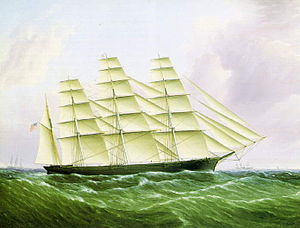 Clipper barque Great Republic, painting by James E. Buttersworth
| |
| History | |
|---|---|
| Name | Great Republic |
| Namesake | Poem by Henry Wadsworth Longfellow |
| Owner |
|
| Ordered | 1852 |
| Builder | Donald McKay (designer & builder) |
| Cost | $ 450,000.00 (1853) |
| Laid down | 1852 |
| Launched | October 4, 1853 |
| Christened | October 4, 1853 by Capt. A. Gifford |
| Maiden voyage | February 24, 1855 to Liverpool, England |
| In service | 1854 |
| Out of service | 1872 |
| Renamed | Denmark in 1869 |
| Homeport | Boston (1853); New York (1855); Yarmouth, Nova Scotia (1866), Liverpool (1868) |
| Identification | |
| Fate | Sunk in storm off Bermuda on March 5, 1872 |
| Badge | figurehead: gilded eagle and a second gilded eagle with outstretched wings across the stern board |
| General characteristics | |
| Class and type | |
| Tonnage |
|
| Displacement | ~6,600 tons (5,000 tons cargo plus 1,600 tons ship's mass)[citation needed] |
| Length | |
| Beam | 53 ft (16 m) |
| Height |
|
| Draught | 25 ft (7.6 m) |
| Decks | 4 continuous wooden decks, after rebuilt: 3 (with additional poop and forecastle decks) |
| Deck clearance | 8 ft |
| Propulsion | Sails |
| Sail plan |
|
| Speed | 19 kn (35.2 km/h) |
| Capacity | 5,000 tons max. |
| Complement | 60; originally planned: 120 |
When launched in 1853, Great Republic was the largest wooden ship in the world. She shared this title with another American-built ship, the steamship Adriatic. She was also the largest full-rigged ship ever built in the United States.[2] She was built by Donald McKay for trade on his own account to Australia.
Just as she was completing loading in New York for her first commercial trip, she was involved in a disastrous fire. She was scuttled to try to save the hull, with only limited success. McKay decided to abandon the wreck to his insurers, who sold the damaged hull to new owners, who rebuilt her with three decks instead of four. She was employed on trans-Atlantic and California routes, with a period under contract to the French government for the Crimean War. She was never used on Australian routes.[3]: 124–129
Even in her rebuilt form, Great Republic had difficulty accessing many ports when fully loaded, due to her great size. She regularly had to partially unload into lighters so that she could then enter locked basins to finish unloading. She did make the fast passages expected of her by McKay – so vindicating the design concept.[3]: 124–129
- ^ Great Republic
- ^ Essex Institute historical collections. Vol. LXIII. Essex Institute. 1927. p. 193. OCLC 6140167.
- ^ a b MacGregor, David R (1993). British and American Clippers: A Comparison of their Design, Construction and Performance. London: Conway Maritime Press Limited. ISBN 0-85177-588-8.